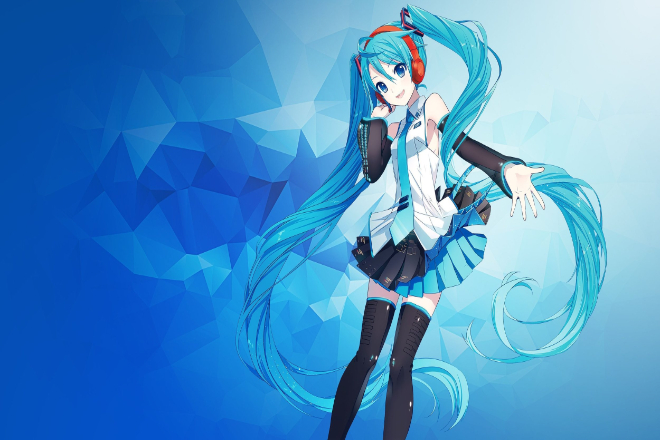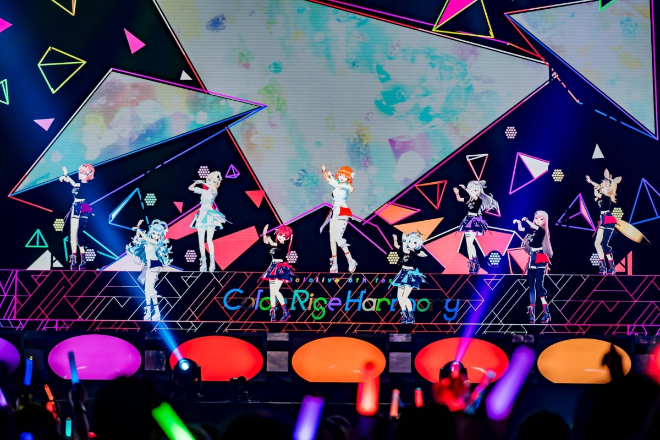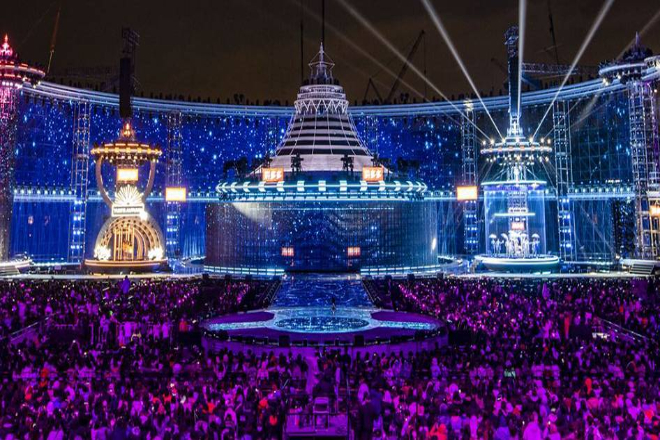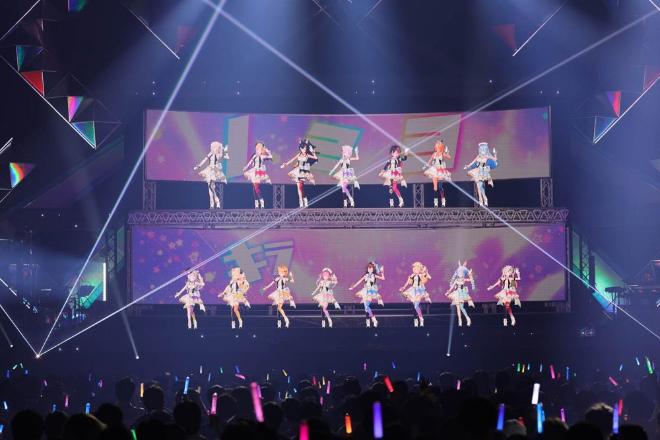Introduction
Les idoles virtuelles, un fantasme organiser créés par la technologie, deviennent les nouveaux favoris de l'industrie du divertissement !
De la tournée mondiale de Hatsune Miku à la popularité des présentateurs virtuels, la scène de performance des idoles virtuelles devient de plus en plus cool.
Mais le saviez-vous ? Créer une telle scène fantastique est indissociable du soutien solide de Afficheurs LED!
Table des matières
1. Qu'est-ce qu'une idole virtuelle ?

En termes simples, les idoles virtuelles sont des stars « créées » par ordinateur. Comme dans les jeux vidéo, un ordinateur crée un personnage particulièrement cool ou mignon.
Donnez-leur des noms, définissez des personnalités, apprenez-leur à chanter et à danser, puis laissez-les « faire des affaires » sur Internet et sur scène pour attirer des fans.
Par exemple, Hatsune Miku, originaire du Japon, est une idole virtuelle particulièrement populaire. C'est une « chanteuse » virtuelle dont la voix est synthétisée par logiciel et dont l'image est celle d'une jolie fille aux cheveux verts.
Ses fans l'apprécient énormément et écrivent des chansons et réalisent des animations pour elle. Elle donne des concerts et sort des albums comme une vraie star.
Les idoles virtuelles présentent de nombreux avantages :
- L'image peut être modifiée à volonté :
Si vous souhaitez qu'elle porte un style ancien aujourd'hui ou un style sportif demain, ou qu'elle change la couleur de ses yeux du bleu au violet, c'est facile. Les vraies idoles ne changent pas aussi facilement.
- Toutes les compétences peuvent être acquises :
Si vous voulez qu'elle chante, danse, joue de la guitare ou même raconte des blagues, vous pouvez le faire grâce à la technologie. Elle pourra ainsi maîtriser plusieurs talents simultanément sans avoir à s'entraîner dur comme les vraies personnes.
- Vous pouvez « opérer » à tout moment et en tout lieu :
Vous n'avez pas à vous soucier de la circulation, de la météo ou de la peur de tomber malade. Vous pouvez apparaître quand vous le souhaitez.
Par exemple, vous pouvez organiser des concerts en ligne dans plusieurs pays en une journée ou discuter avec des fans dans plusieurs salles de diffusion en direct en même temps.
- Interagir avec les fans est super amusant :
Les idoles virtuelles peuvent discuter avec leurs fans grâce à l'intelligence artificielle. Lorsque les fans envoient des commentaires, elle peut répondre immédiatement, et ils peuvent également jouer ensemble, se sentant comme des amis.
2. Quelles sont les exigences relatives aux écrans d’affichage LED sur la scène de performance de l’idole virtuelle ?

Les performances des idoles virtuelles dépendent entièrement des effets visuels, et l'image sur l'écran LED doit être suffisamment éblouissante.
Le résolution doit être élevé pour que les détails des idoles virtuelles puissent être affichés, tels que leurs traits délicats du visage, leurs vêtements magnifiques et leurs effets spéciaux sympas.
La couleur doit également être précise et exempte de dominantes, sinon les idoles virtuelles paraîtront irréelles.
Le fréquence de rafraîchissement doit être élevé et le délai faible. Sinon, le public sera distrait par l'écran s'il se fige.
De plus, peu importe où se trouve le public, il peut voir une image claire, ce qui nécessite que l'écran ait un angle de vision suffisamment large.
En bref, l’écran doit faire en sorte que le public tombe amoureux de la performance de l’idole virtuelle au premier regard.
L'environnement scénique des idoles virtuelles est très complexe et l'écran LED doit pouvoir y résister.
S'il s'agit d'un spectacle en extérieur, l'écran doit être étanche à l'eau et à la poussière. Sinon, il risque de se dégrader après une averse.
De plus, quel que soit le temps, l'écran doit fonctionner normalement et ne pas subir de problèmes liés aux variations de température. Même en intérieur, l'écran doit être stable en cas d'humidité ou de poussière sur la scène.
En bref, l’écran doit être comme un « homme de fer » et pouvoir faire face à n’importe quel environnement.
Les performances des idoles virtuelles sont variées et les fonctions des écrans d'affichage LED doivent suivre.
L'écran doit pouvoir lire des vidéos haute définition et afficher des images et du texte, ainsi que de la musique, en même temps afin de répondre aux différents besoins de la performance.
De plus, la forme de l'écran est également très importante. Parfois, la scène nécessite un écran incurvé, un écran incurvé ou un écran de sol pour créer un effet visuel unique.
Plus important encore, l'écran doit pouvoir interagir avec le public, par exemple grâce à la réalité augmentée, afin que celui-ci ait l'impression d'être dans le même espace que l'idole virtuelle. Ainsi, le public trouvera le jeu amusant et sera captivé.
Lors de la performance de l'idole virtuelle, l'écran doit être stable et performant, et assurer une bonne dissipation de la chaleur.
Sinon, il chauffera après avoir fonctionné pendant une longue période et causera facilement des problèmes.
De plus, l’écran doit être parfaitement synchronisé avec les autres équipements présents sur la scène, tels que les caméras et les systèmes de capture de mouvement.
Si l'image à l'écran et les mouvements de l'idole virtuelle ne correspondent pas, la performance sera gâchée.
En bref, l’écran doit être comme un partenaire fiable et ne pas être laissé de côté dans les moments critiques.
Le temps de mise en place de la scène est serré, l'écran d'affichage LED doit donc être facile à installer.
Il est préférable d’être modulaire, comme des blocs de construction, qui peuvent être rapidement installés et retirés.
Si l'écran est cassé, il doit être réparé rapidement et l'ensemble des performances ne peut pas être retardé à cause d'un petit problème.
En bref, l’écran doit être facile à utiliser et ne pas poser de problèmes pour la construction et l’entretien de la scène.
3. Comment utiliser un écran LED pour créer une scène de performance d'idole virtuelle

Étant donné que la performance des idoles virtuelles repose davantage sur des moyens de haute technologie tels que la réalité virtuelle, la réalité augmentée et la projection holographique, le rôle de l'écran d'affichage LED ici ressemble davantage à une « toile magique » pour présenter des idoles virtuelles et diverses scènes fantastiques.
1). Créer un arrière-plan immersif
L'objectif de la scène des idoles virtuelles est de créer un espace fantastique et immersif. Des écrans LED peuvent être utilisés pour présenter le monde virtuel des idoles virtuelles.
Par exemple, si l’idole virtuelle vient du monde futur, l’écran d’affichage peut afficher des néons clignotants, des voitures volantes et des bâtiments de haute technologie.
S'il s'agit d'un thème de forêt fantastique, vous pouvez montrer une forêt avec des lumières et des ombres entrelacées, des plantes en mouvement et des créatures mystérieuses.
Ces images d’arrière-plan doivent être parfaitement synchronisées avec les mouvements et le rythme musical des idoles virtuelles afin que le public ait l’impression d’être dans le monde des idoles virtuelles.
2). Utiliser des écrans LED pour « agrandir » la scène
La scène des idoles virtuelles doit souvent dépasser les limites des scènes traditionnelles. Les écrans LED peuvent agrandir la scène et la rendre plus complexe grâce à des raccords et une disposition créative.
Par exemple, des écrans incurvés ou des écrans surround peuvent être utilisés pour créer une sensation d'encerclement du public ou des écrans d'affichage peuvent être installés au-dessus et sur les côtés de la scène pour « étendre » l'espace de performance des idoles virtuelles jusqu'au sommet et autour du public.
De cette façon, les idoles virtuelles peuvent « voyager » sur ces écrans, et la perspective du public sera plus riche.
3). Réaliser l'interaction entre le virtuel et la réalité
L'un des points forts de la scène des idoles virtuelles réside dans l'interaction entre virtuel et réalité. Des écrans LED permettent de capturer les mouvements des idoles virtuelles en temps réel grâce à la technologie de capture de mouvement et de les afficher à l'écran.
Par exemple, lorsque des idoles virtuelles dansent sur scène, l'écran d'affichage peut afficher de manière synchrone leurs mouvements de danse et même ajouter des effets spéciaux, tels que des traînées de lumière derrière elles ou des pétales virtuels apparaissant sous leurs pieds.
De plus, le public peut également interagir avec l'écran d'affichage via des téléphones portables ou d'autres appareils, comme voter pour décider des costumes des idoles virtuelles ou choisir une musique de fond, et ces contenus interactifs peuvent être affichés sur l'écran LED en temps réel.
4). Utiliser les effets spéciaux des écrans LED
La scène des idoles virtuelles nécessite des effets « magiques » pour attirer le public. Les écrans LED permettent de produire des effets spéciaux, comme des écrans transparents. à l'oeil nu 3D effets ou projection holographique.
Les écrans transparents peuvent faire « flotter » des idoles virtuelles dans les airs sur la scène ou laisser apparaître les images d’arrière-plan à travers eux, créant ainsi une sensation de rêve.
Les effets 3D à l’œil nu permettent au public de voir des images en trois dimensions sans porter de lunettes.
Des idoles virtuelles jaillissant de l'écran ou des accessoires virtuels volant de l'écran vers le public… Ces effets spéciaux rendront la scène plus attrayante.
5). Adaptation flexible et mise à jour rapide du contenu
Le contenu des performances des idoles virtuelles est souvent mis à jour et les écrans d'affichage LED doivent pouvoir modifier et ajuster rapidement le contenu.
Par exemple, en fonction des différents thèmes de performance ou des commentaires des fans, l'image d'arrière-plan, les effets spéciaux ou les liens interactifs peuvent être modifiés à tout moment.
Le système de gestion de contenu de l'écran d'affichage doit être simple et facile à utiliser afin que le personnel puisse l'exploiter en temps réel afin que la scène de l'idole virtuelle puisse toujours rester fraîche.
4. Outre l’écran d’affichage LED, quelles autres technologies sont nécessaires pour « coopérer » ?

1). Technologie de capture de mouvement :
Le cœur de la performance de l’idole virtuelle est que les mouvements doivent être fluides et naturels.
La technologie de capture de mouvement consiste à mettre une « combinaison de détection » spéciale sur l'acteur ou à installer des caméras sur la scène pour capturer les mouvements et les expressions de l'acteur.
Ces mouvements seront transmis à l'ordinateur en temps réel puis affichés sur l'écran d'affichage LED.
Par exemple, lorsque l'idole virtuelle danse sur scène, l'écran d'affichage LED affichera de manière synchrone les mouvements de l'idole virtuelle afin que le public puisse voir l'image comme si l'idole virtuelle était vraiment sur scène.
De cette façon, l'idole virtuelle peut se déplacer au rythme de la musique, et les mouvements sont particulièrement fluides.
2). Technologie de projection holographique :
La technologie de projection holographique revient à ouvrir un « portail » pour les idoles virtuelles, leur permettant d’apparaître sur scène en 3D.
Les idoles virtuelles vues par le public donnent l'impression qu'elles se tiennent réellement sur scène et peuvent même interagir avec de vraies personnes.
Par exemple, l’image virtuelle de Teresa Teng peut chanter avec Zhou Shen parce que la technologie de projection holographique a « attiré » l’idole virtuelle dans la réalité.
L'écran LED peut être utilisé comme arrière-plan de projection holographique pour montrer les scènes dynamiques de l'idole virtuelle, comme un ciel étoilé derrière l'idole virtuelle ou des fleurs virtuelles surgissant sous ses pieds, rendant toute la scène plus fantastique.
3). Technologie AR et VR : laissez le public « voyager » dans le monde virtuel
La technologie AR (réalité augmentée) permet de « superposer » des éléments virtuels sur la scène réelle, comme un ciel étoilé apparaissant soudainement derrière l’idole virtuelle ou des fleurs virtuelles surgissant sous ses pieds.
La technologie de réalité virtuelle (VR) est encore plus puissante. Portant des lunettes de VR, le public peut entrer pleinement dans l'univers de l'idole virtuelle, comme s'il participait pleinement au spectacle.
Par exemple, lors de certains concerts d'idoles virtuelles, après que le public ait mis des lunettes VR, il a l'impression d'être à côté de l'idole virtuelle, ce qui est super cool !
L'écran LED peut être utilisé comme support visuel de la technologie AR et VR, par exemple pour afficher les scènes interactives d'idoles virtuelles sur scène.
Ou affichez l'arrière-plan dynamique de l'idole virtuelle via l'écran LED, permettant au public de basculer de manière transparente entre la réalité et la virtualité.
4). Technologie de rendu en temps réel :
Les images des performances des idoles virtuelles doivent être rendues en temps réel. Sinon, elles se figeront et le public sera mal à l'aise.
La technologie de rendu en temps réel revient à ajouter un « accélérateur » à l'image afin que les mouvements et les images d'arrière-plan de l'idole virtuelle puissent être affichés en douceur.
Par exemple, lorsque l'idole virtuelle danse sur scène, l'image d'arrière-plan évolue au rythme de la scène et ne se fige pas. C'est le mérite de la technologie de rendu en temps réel.
En tant que « grande toile » pour l’affichage d’images, l’écran d’affichage LED peut présenter ces images fluides en temps réel afin que chaque image vue par le public soit extrêmement claire.
5). Équipement de traitement et de contrôle vidéo :
Avec autant d’images intéressantes, des équipements de traitement et de contrôle vidéo sont également nécessaires pour les « diriger ».
Ces appareils peuvent ajuster la couleur et la luminosité de l'image et peuvent également assembler plusieurs images pour rendre l'ensemble de la scène plus parfait.
Par exemple, si les idoles virtuelles et les images d’arrière-plan sur la scène doivent être parfaitement intégrées, ces appareils doivent être « réglés ».
En tant que dispositif d'affichage final, l'écran d'affichage LED a besoin de ces dispositifs de traitement et de contrôle vidéo pour garantir la qualité et l'effet de l'image afin que l'image vue par le public soit à la fois belle et coordonnée.
5. Conclusion
Une performance réussie d’une idole virtuelle n’est pas seulement une démonstration de technologie, mais aussi une fusion parfaite de l’art et de la technologie.
En tant que cœur de la scène, l'écran d'affichage LED est crucial dans chaque détail, de la haute résolution à l'expérience interactive, de l'adaptation environnementale à la stabilité du système.
Le soutien de technologies de pointe telles que la capture de mouvement, la projection holographique, la RA/RV, etc., a permis à la scène des idoles virtuelles de dépasser les limites de l'imagination.
Enfin, si vous souhaitez en savoir plus sur les écrans d'affichage LED, veuillez nous contacter.
Vous pourriez être intéressé par :
Autres articles sur l'affichage LED de scène :
